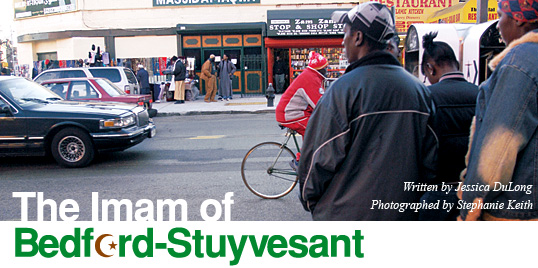
 he summer heat draws people onto the Brooklyn street. Shopkeepers in doorways call to passersby about caps, socks and belts for sale. Young mothers push strollers heavy with plastic shopping bags slung over the handles. Delivery trucks veer around potholes, jockeying for position with chrome-detailed sports cars thumping hip-hop. It’s Friday afternoon, and the promise of the weekend lightens the air.
At the corner of Bedford Avenue and Fulton Street sits a freshly painted green and yellow building with a new sign that reads “Masjid at-Taqwa,”
a transliteration of the Arabic for “mosque of God-consciousness.”
In an instant, the end of afternoon prayers transforms the streetscape as women in colorful robes and bright headscarves pour from the mosque’s back door. The sidewalk is awash in color: An emerald robe with intricately embroidered sleeves; a yellow shalwar kamees trouser-and-tunic set peppered with white splotches; candy pink with lime green accents.
he summer heat draws people onto the Brooklyn street. Shopkeepers in doorways call to passersby about caps, socks and belts for sale. Young mothers push strollers heavy with plastic shopping bags slung over the handles. Delivery trucks veer around potholes, jockeying for position with chrome-detailed sports cars thumping hip-hop. It’s Friday afternoon, and the promise of the weekend lightens the air.
At the corner of Bedford Avenue and Fulton Street sits a freshly painted green and yellow building with a new sign that reads “Masjid at-Taqwa,”
a transliteration of the Arabic for “mosque of God-consciousness.”
In an instant, the end of afternoon prayers transforms the streetscape as women in colorful robes and bright headscarves pour from the mosque’s back door. The sidewalk is awash in color: An emerald robe with intricately embroidered sleeves; a yellow shalwar kamees trouser-and-tunic set peppered with white splotches; candy pink with lime green accents.
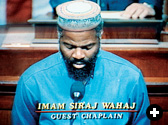 |
| In 1991, Wahhaj became the first Muslim to offer the invocation before a session of the US House of Representatives. |
Men exit the front of the mosque, several hundred of them, many wearing knit skullcaps, some with only socks
on their feet, shoes still in hand. Men
in do-rags, sports jerseys and fatigues linger alongside others in embroidered tunics. A bearded man in cargo blue jeans and a Yankees cap wears a black T-shirt with the word “Muslim” in white letters that form the shape of a city skyline. He greets a friend with a wide-armed embrace and calls him “my brother.” Clusters of congregants stand before the Abu Bakers [sic] Bakery, which offers cheesecake below the message: “There is no god except Allah.”
There’s no trace, these days, of the more than a dozen crack houses whose denizens threatened residents, business owners and worshipers alike on these streets in the 1980’s. In those days pedestrians rushed rather than strolled, and shopkeepers either left or took cover behind bulletproof glass.
One man, Siraj Wahhaj, has led this transformation. He is Masjid at-Taqwa’s founder and imam, or spiritual leader. Praised as one of the most dynamic
and charismatic Muslim leaders in the United States, Wahhaj travels widely, lecturing and preaching at Islamic
centers, conventions, fundraisers and universities. In 1991, he became the first Muslim to lead a prayer before
the us Congress. But most days, his focus is much closer to home.
Down a long hallway that serves as the hub of mosque administration sits
a humble office, its walls virtually tiled with awards, certificates and commendations. (One proclaims August 15, 2003 “Imam Siraj Wahhaj Day” in honor of a “lifetime of outstanding and meaningful achievement,” by order of Brooklyn Borough President Marty Markowitz.) A desk stacked high with books seems to reflect Wahhaj’s harried schedule. On a Wednesday in August, he’s preparing a lecture for the Islamic Society of North America’s conference; it’s titled “American Muslims: Loving My Country, Living Islam.”
 |
| Imam Siraj Wahhaj speaks with city council candidate Naquan Muhammad (far left). |
His speech shifts seamlessly between English and the Arabic he uses in quoting the Qur’an, but his accent remains distinctly Brooklyn. His gray beard and poised demeanor establish him as a scholar, but when
he preaches, the cadences and crescendos recall his Baptist upbringing in New York City public housing and
his early admiration for the oratory
of Martin Luther King, Jr.
“It’s not contradictory for me as
an American to be a Muslim. Nor is
it for an American to be a Christian
or a Jew or a Sikh or a Hindu or even an atheist, for that matter. That’s what makes America what it is.” The beauty of the country, he argues, is that you get exposed to other people and other religions. “We grew up in an inte-
grated society. We know what it’s
like to be friends with Christians and Jews and whites and Hispanics and Chinese, because that’s what we do
in this country.”
He wistfully reflects on the diverse group of friends he had in high school —evidenced, he says, by a yearbook full of scrawled messages—but Wahhaj has traveled a long road, and it hasn’t always been so generously inclusive. He counts himself among the generation of African–Americans who came to Islam in the 1960’s and 1970’s through the black separatist movement—Wahhaj became a Muslim in 1969—and there was a time, he explains in an even-keeled voice, when he preached that “white people are devils.” That was the separatist party line, he says. “I preached it. I taught it.”
While Wahhaj credits the Nation
of Islam for giving him “black pride,” he now says that the pride went too
far when it spilled over into denigration
of others. “In those few years with
the Nation of Islam, I was other than myself,” he concedes. But in the late 1970’s, as Wallace D. Muhammad led many Nation of Islam followers back toward orthodox Islam, Wahhaj was among them.
“It came very natural to me,” he says. “I respect myself, I love myself, but not to the detriment of others. I can respect and love other people. Islam crystallized that.” In 1978, Wahhaj traveled to Naperville, Illinois for six weeks of Saudi-sponsored religious training, and he was among five students chosen to receive advanced training in Makkah.
There, he spent four months at Um al-Qura University with teachers and students from all over the globe. “I felt so pure,” he recalls. “I didn’t watch any tv. It was just pure spiritual.” Waking each morning before dawn, he was the first student at the mosque each day, and he often stayed after class with
his teachers. “I used to run around the track and say to myself, ‘Okay, when I get back to America I’m going to help the Muslims there. I’m going to start training the people, teaching them what I learned.’ It was like a boxer preparing for a match.”
But when he landed back in New York, he says, the clash between his faith and American life was jarring and discouraging, and he recalls feeling ill with the shock. He nevertheless started a mosque in 1981 in a friend’s Brooklyn apartment, where they moved the furniture aside to accommodate a couple dozen worshipers. Soon after, the congregation bought an abandoned clothing store at a city auction for $29,000. The address was 1266 Bedford Avenue. After kicking out the drug addicts, Wahhaj and his congregants set the space up as a mosque. Today, that mosque is Masjid at-Taqwa.
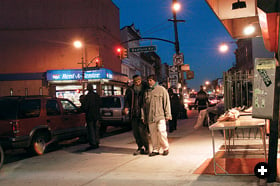 |
| Two recent immigrants, one now a local shop-owner, walk past the Bedford Avenue corner. |
Just inside the mosque’s front door sits a table that’s permanently sticky from the doughnuts, bagels and cookies offered free each day. Above the table is a bulletin board covered with flyers offering everything from summer Arabic classes to halal beef jerky to legal help. A large gray trash barrel on wheels filled with black
plastic bags occupies the center of
the foyer; from it, worshipers snatch up bags to put their shoes in during prayers. Behind clear glass doors, the prayer hall is a simple room, a little dingy despite thick coats of green and yellow paint. The floor is covered in alternating strips of green and gray carpeting laid on a diagonal slant to indicate the qibla, the direction of prayer.
In his sermons, Wahhaj urges “complete obedience, complete love and complete compliance with the commandments,” but recognizes that heeding that call is a tremendous strain.
For many, the conflict begins in adolescence. “What are you going to do now when it’s time for prayer?” he prods young Muslims who are making the transition from Muslim schools to public schools. “In Muslim school it’s easy. When it’s time for prayer, everybody prays.” He has witnessed the struggle in teenagers who tell him, “I can’t be
a Muslim in this society. It’s too much. I wanna date. I wanna drink my beer.
I want to be like everybody else.” When he counsels them, he says, he does it from family experience: He sent his eight surviving children, now aged 13 to 33, to Muslim schools, and today seven are practicing Muslims.
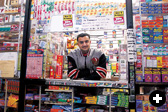 |
| The neighborhood’s flourishing “Muslim economy” includes a deli, a convenience store, and the Halal Restaurant. Joint efforts by police and Muslim civilian patrols organized by Wahhaj reclaimed the area from drugs and crime. |
“Wahhaj appeals to youth—not only to the African–American Muslim community, but he also has a huge following among the immigrant communities,” says Naeem Baig, secretary general of the New York-based Islamic Circle of North America. “He’s a person who offers some solutions to problems. That’s what makes him different. He talks about things of concern to everyone.” This, says Baig, makes him a “true Islamic leader.”
Perhaps nothing proved his leadership more than the clean-up-the-neighborhood campaign Wahhaj began in earnest in 1988. Throughout the 1980’s, crack cocaine had been rampant in New York City, and the mosque’s neighborhood, Bedford-Stuyvesant, was among the hardest hit. “We had gun traffic
and gunplay in the area of the masjid,” Wahhaj explains. “Oftentimes we could actually hear gunfire and bullets flying on our property. One day we decided to put an end to it.”
Eric Bullen recalls that his store, Al’s Men Shop at 1140 Fulton, was one of the few functioning businesses on what had become a block of vacant storefronts. “It used to be so bad
at times that people didn’t want
to even be seen out here too late. You could guarantee that, had they come through once it started to
get dark, they were going to get mugged,” he recalls. The Muslims, he says, were instrumental in changing things.
Wahhaj called the head of the 79th police precinct and told him that “one of the problems when you raid these crack houses is the dealers come back the next day. You can’t keep them closed.” He offered a deal: The police would raid the crack houses, and then members of his congregation would keep the dealers from returning. The police agreed. For the next 40 days and nights, 24 hours a day, in the cold New York winter, Muslim brothers patrolled the streets on foot and in cars, preventing the dealers and buyers from entering the raided buildings.
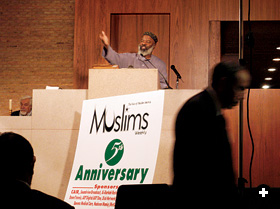 |
|
“When you come to America with all its freedoms and you still practice Islam, that’s the most gratifying thing to me,” says Wahhaj, whose sermons now address ever-growing numbers of immigrants from Asia and Africa. |
Standing outside the mosque in a bright dashiki and matching cap, Farid A. Malik positions himself before a folding table spread with literature, his hand outstretched to passersby offering thick paperback copies of the Qur’an. “Would you like to learn about Islam?” he calls to them. Malik was one of the men who patrolled the streets. “We became a barrier between the drug dealer and the drug user,” he says, explaining that after getting off work at midnight, he would patrol from one in the morning until sunrise. “It’s your job to make the world better,” he says. “Our faith commands us to encourage right and to forbid wrong. You must stop it with your hands, speak out against it, or at least hate it with your heart.” He still recalls an elderly Christian woman stopping him on the street to say thank you. “Praise the Lord,” she said. “Keep up the good work, son.”
The patrols received international news coverage not only because they were effective, but also because the cooperation between local Muslims and the police was unprecedented. Community Affairs Officer Steven Ruffin was
a patrolman in the neighborhood at
the time. “When you’re on patrol, you know your trouble spots,” he recalls. “That area was known as one of our trouble spots.” What impressed Ruffin about Wahhaj was his ability to rally support, first among his congregants and later from mosques in other parts of the city. “He was able to galvanize, to get them to do civilian patrol.” Since then the neighborhood has changed drastically, says Ruffin. “Being that it’s a main thoroughfare, that corner is one of the safest areas.” As Muslims are required to pray five times a day, there’s a constant influx of people around the mosque, he explains, which lends a sense of security.
When Wahhaj first scouted out the Bedford Avenue location, the neighborhood had not a single Muslim-owned shop. Now, there is a local “Muslim economy,” with clothing, food and book stores as well as vendors who sell prayer rugs, incense and oils, skullcaps and videos and DVD’s of Muslim teachings on makeshift display tables outside the mosque. After services, clusters of congregants gather under the awning of the Halal Restaurant, whose sign reads “No More Junk, Eat Healthy.”
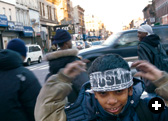 |
| Outside the mosque, a boy ties on a headband that reads “Muslim: Total Submission.” |
“There are more Muslims here than ever before, especially Africans and Bangladeshis,” Wahhaj explains. Nearly all the mosque’s early congregants were African–American, he says, but today, African–Americans, white Americans and Hispanic Americans total just 40 percent of the congregation: The majority are immigrants from Afghanistan, Egypt, Bangladesh, Sudan, Palestine, Pakistan, Guinea, Senegal, Somalia and other places.
Some immigrants find that America’s liberties threaten their faith and traditions, Wahhaj explains, and “they fail the test when given that kind of freedom.” But others, he adds, devote themselves more fervently to their religion here than they did in their home countries. “Some of them have told us that, ironically, they started really practicing after they came here.” As the mosque’s spiritual leader—Islam does not have an ordained clergy—Wahhaj strives to keep the faithful in the fold and to offer a communal space that supports them all. “When you come
to America with all its freedoms and you still practice Islam, that’s the most gratifying thing to me.”
These days, Wahhaj sprinkles in more Arabic and uses fewer English idioms in his sermons, which now have a more international focus to match his more
international congregation. “I include Muslims around the world in my sermons,” he says. “My scope is more universal.”
 |
Jessica DuLong (media@jessicadulong.com) is a free-lance journalist in Brooklyn, NY who has written for Newsweek International, Rolling Stone, Parenting, CosmoGIRL! and Newsday, among other publications. |
 |
Stephanie Keith (stephaniekeith@earthlink.net) is
a free-lance photographer in New York City. She recently exhibited her photographs of Egyptian Ramadan television serials (“Prime-Time Ramadan,” N/D 03) in Cairo. |